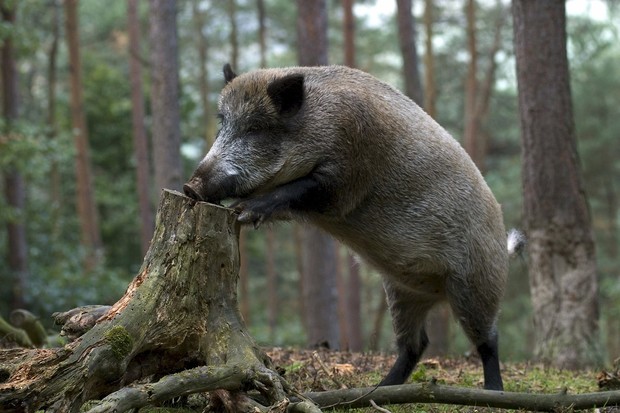Backwoods: habitat of bear expands and gets closer to Kazan
A ban on black grouse, long-awaited increase in population of roe deer and harmless wild boar
In Tatarstan, bears have began getting closer and closer to human settlements, including to Kazan, and roe deer finally have stopped to escape from the Republic due to unsuitable climate conditions in winter. The details were discussed at a press-conferences in Tatar-inform dedicated to the fight against poachers and the organization of a winter wildlife census. As the correspondent of Realnoe Vremya found out, now the inspectors in the Republic are provided with equipment at the level of poachers, which helps to increase the number of caught violators. In order to ensure the wild animals do not wander to Kazan, their feeding grounds have been moved inwards the hunting sectors.
The government started to tackle poaching
Every year a number of caught poachers is growing in Tatarstan. The head of the department for supervision over the use of wildlife objects in the Republic of Tatarstan Radik Mutakharov links the growth in the number of recorded violations with special attention that the government has started to pay to the fight against poaching. So, just in the last two years, in addition to an increase in the number of inspectors, it has been also purchased modern equipment: in each municipal district each employee has snowmobiles of foreign production in winter.
''The equipping of the employees is not inferior to ones of poachers and, of course, it is difficult to escape for them now,'' said Mutakharov. However, there is still something to strive for: in each municipal district there should be three inspectors, but in Tatarstan there is only one yet. ''We have a program. Perhaps, we will achieve this,' hesitantly said the speaker.

As for the last year's results, it should be noted that according to the article No. 258 of the Criminal Code (Illegal hunting) there were initiated 30 criminal cases.
Punishment for violations may be a confiscation of weapons and equipment, and the deprivation of the right to hunt for three years and even a probation up to two years. Once, a poacher was confiscated of a snowmobile, the cost of which was estimated at 800 thousand rubles, an expensive gun and he was sentenced to 300 hours of work.
Are bears reaching Kazan?
Every winter throughout Russia it is held a winter route census. In Tatarstan, it runs from 1 January to 28 February, but prior to that they define the routes. The head od the department of licensing, state accounting, cadastre and regulation of the use of wildlife objects in the Republic of Tatarstan Rinat Chispiyakov told that they count footprints left by animals during a day. Then they determine the total number of animals.
At the moment, in the Republic there are 16-17 species of hunting animals. In 2016, in Tatarstan there were recorded 6 200 wild boars, 7 100 elks, 20 000 rabbits, 6 000 foxes, 90 000 partridges, 50 000 black grouse, 2 000 grouse and 2 000 deer. Grouses and deer in Tatarstan have been tenderly and carefully cultivated for years and now they enjoy the current results of the work because in the 2000s they were only 400. Once foresters even tried to bring roe deer from the Kurgan Oblast, but in winter the animals still left the Republic. Trial hunting for deer was open in 2011, now a permission to shoot can be obtained only in rare cases.
A year and a half ago, the President of Tatarstan also made a decision to limit hunting on some kinds of hunting resources. The decision was made due to the fact it has been recorded a decrease of hares, wood grouse, black grouse, grouse and partridge. In the end, hunting for them was banned until 2017, and the ban for grouse is valid for the upcoming spring season. When the hunting on these animals is opened it will be decided by the results of the 2017 census.

The news was the fact that the habitat of the bear turns out to be more expanded and is reaching Kazan.
''Its habitat is expanding and is reaching Kazan. Before, it was confined to areas that are on the border with the Kirov Oblast, the Mari-El Republic, the Udmurt Republic, now its range is beginning to expand. Bear appeared in Rybno-Slobodskoy district, Pestretsy, recently they have been observed in Laishevo district at the border with Kazan. That is, this species has a tendency to increase in population,'' said the head of the department of licensing, state census, cadastre and regulation of the use of wildlife objects in the Republic of Tatarstan.
However, the changes have occurred not only in the habitat of bear. Before, bears used the Tatarstan Republic as a transit point, after which they moved on, now they have settled down in the Republic and even made their dens.
Wild boar in the city is not a problem
Recent years have been remembered by many people by the invasion of wild boars in the Republic's capital. An unusual event in 2014 was that on the highway near Kazan a driver knocked down nine boars. Another herd of wild boars was seen in the area of the Severny station. The topic of artiodactyls continued into 2015, when they again appeared in the city and was captured on photos and videos. Last year, the animal activity continued. For example, in September, a herd of boars tried to cross a road in the center of Kazan on the street Said Galeyeva, however, frightened by a car horn, rushed back into the bushes. Not only wild boars but also deer happened to walk around the city. In 2016, there were at least two such cases.
Answering the question of Realnoe Vremya, the head of the department of licensing, state census, cadastre and regulation of the use of wildlife objects in the Republic of Tatarstan Rinat Chispiyakov said that last year there were 42 accidents involving wild animals, the approximate damage to the hunting grounds amounted to 1.7 million rubles.

He associates an increased activity of animals with an increase in their population and with expanding urban environment. The speaker sees nothing bad in this.
''It's natural. They live in their natural habitat. Birds fly in the city, squirrels live there, however, they are also game species. Wild boars do not attack people, so there's nothing to be afraid of.''
According to him, we should not take issue with the appearance of wild animal in the city seriously, but measures to ensure safety are still being taken.
''Feeding areas on the border has been moved inwards of the hunting farms to reduce the migration of wild boars in the direction of human settlements. But wild boar, like other animals, in any case leave a place where there are anthropogenic conditions, where construction begins. There are a few cases and I don't think this is a problem,'' said the head of the department of licensing, state accounting, cadastre and regulation of the use of wildlife objects in the Republic of Tatarstan.